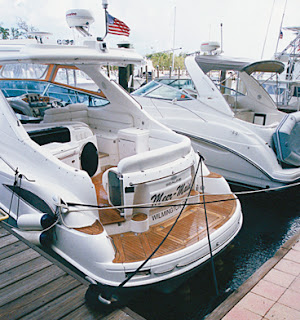* * * * * * * * *
Hurricane and storm preparation begins well before a threat.
By Vincent Daniello
The southeastern United States isn't the only hurricane-prone region. A year prior to Andrew, the 1991 hurricane season was equally inactive, yet Hurricane Bob slammed boats ashore in an ill-prepared Rhode Island, and seemingly innocuous Hurricane Grace fizzled but then became part of the catastrophe known as the Halloween Storm to New Englanders or the Perfect Storm of book and movie infamy.
Whether dealing with hurricanes or early winter storms, three rules should guide storm prep. First, even "weak" storms can pack an unexpected wallop. Second, preparation must be organized in advance so it's simple and quick. Finally, local topography and just plain luck are deciding factors, but these can be played advantageously. Follow these tips to prepare.
Reduce Windage
Where Sensible Force increases by the square of the wind velocity. Five square yards of flat surface generate about 10 pounds of pressure in a 10-knot breeze. At 30 knots, the same 5 yards creates 90 pounds of force and at 100 knots, 1,000 pounds. Taking down canvas may well prevent extensive damage to far more than just that canvas in a direct hit from a Category 2 or better storm. But the odds of being in the usually small area of devastation are small. More likely, a near miss provides a day or two of strong wind and heavy rain with little damage — unless taking down that canvas left expensive electronics unnecessarily exposed to the weather. Either way, cover the helm with plastic or a tarp secured with rope and waterproof tape, but consider leaving helm enclosures erect.
Duplicate Lines
Bypass the closest cleat or piling and choose an attachment point farther away so lines remain snug through an unusually high or low tide. Don't just double up lines. A cleat or piling is just as likely to fail as the line. A rule of thumb is that each line should have a mate running in the same direction but attached at a different place on both the boat and the dock.
There Are Never Too Many Lines or Fenders
One boat owner returned to his 65-footer after Hurricane Frances hit South Florida to find that every line failed due to chafe or broken cleats and pilings — except the very last line he put on. The boat was gently swaying in the breeze, held by a line tied through the bow pulpit anchor slot and around the concrete main dock.
Protect Lines From Chafe
Used fire hose is the best chafe gear available — the double-jacketed rubber and canvas kind professional firefighters use, not cotton hose found in high-rise fire systems. Years ago, any local fire station had a roll or two of leaky hose they'd give away. Now it's available online for about $50 for 100 feet. Store-bought chafing gear is also a good choice, but rubber or plastic hose isn't going to hold up. For tricky chafe problems like concrete pilings, have thimbles spliced in line ends and use chain. When used around floating dock pilings, the chain rises and falls with the dock. Nylon lines stretch up to half their length, so use long lengths of chafing gear.
Protect Yourself
Boats can be repaired or replaced; people can't. It's cliché but often forgotten in the rush to ready for a storm, particularly when preparations weren't made in advance. Allow time before the storm to evacuate or take care of house and family needs, which means at some point, whatever is done to the boat will have to be good enough. Take photos of preparations and of neighboring boats — insurance companies might require proof you didn't just leave the boat unprepared and hope for the best or that your neighbor did. Digital images are fine, but it's wise to take at least a few photos on film since they are much harder to alter, so they're better in court. Copy important boat papers, particularly insurance polices, and keep them somewhere safe — even mail them to family living elsewhere. When returning to the boat after the storm, watch for live electrical wires, exposed nails, splintered wood or jagged metal.
Luck
The damage from a hurricane can be quite sporadic. Boats or houses on one side of a canal might be destroyed while the other side sustained only moderate damage. Storms behave differently too. In Florida's 2004 hurricane season, Category 2 Hurricane Frances came ashore very slowly, so it did as much or more damage as Category 3 Hurricane Jeanne. The next year, Hurricane Wilma was expected to weaken to Category 1 status as it crossed Florida and interacted with a strong October cold front. But that cold air created severe thunderstorms around the eye of the storm that chewed across the state like teeth in a saw. Damage was much more widespread and, in many places, far more severe than from storms the previous year.
In 2003, Hurricane Isabel came ashore in North Carolina as a rapidly weakening Category 2 storm and became a tropical storm before reaching the Chesapeake Bay, but it took just the right track for winds to push high storm surges up the bay — even an 11-foot surge 100 miles up the Potomac River at Washington, D.C.
These examples show just how random storm damage can be and should serve as a reminder to never take the need for preparation lightly. When it comes to severe weather, bad luck happens, but good luck is made.



No comments:
Post a Comment